A High-Sensitivity Fiber Optic Soil Moisture Sensor Based on D-Shaped Fiber and Tin Oxide Thin Film Coatings
Abstract
1. Introduction
2. Materials and Methods
2.1. Fabrication of D-Shaped Multimode Fibers
2.2. Sensor Design Based on Lossy Mode Resonance
3. Experimental Details
3.1. D-Shaped Fiber Sensor Coated with SnO2 Thin Film
3.2. Experiment on LMR Soil Moisture Sensor
4. Results and Discussion
4.1. Sensitivity
4.2. Response Time Test
5. Conclusions
Author Contributions
Funding
Institutional Review Board Statement
Informed Consent Statement
Data Availability Statement
Acknowledgments
Conflicts of Interest
References
- Topp, G.C.; Davis, J.L.; Annan, A.P. Electromagnetic Determination of Soil Water Content: Measurements in Coaxial Transmission Lines. Water Resour. Res. 1980, 16, 574–582. [Google Scholar] [CrossRef]
- Robinson, D.A.; Jones, S.B.; Wraith, J.M.; Or, D.; Friedman, S.P. A Review of Advances in Dielectric and Electrical Conductivity Measurement in Soils Using Time Domain Reflectometry. Vadose Zone J. 2003, 2, 444–475. [Google Scholar] [CrossRef]
- Blonquist, J.M., Jr.; Jones, S.B.; Robinson, D.A. A Time Domain Transmission Sensor with TDR Performance Characteristics. J. Hydrol. 2005, 314, 235–245. [Google Scholar] [CrossRef]
- Qu, W.; Bogena, H.R.; Huisman, J.A.; Vereecken, H. Calibration of a Novel Low-Cost Soil Water Content Sensor Based on a Ring Oscillator. Vadose Zone J. 2013, 12, vzj2012.0139. [Google Scholar] [CrossRef]
- Muñoz-Carpena, R. Field Devices for Monitoring Soil Water Content; University of Florida: Gainesville, FL, USA, 2004; Available online: https://edis.ifas.ufl.edu/publication/AE266 (accessed on 3 June 2024).
- Liu, H.H.; Hu, D.J.J.; Sun, Q.Z.; Wei, L.; Li, K.W.; Liao, C.; Li, B.; Zhao, C.; Dong, X.; Tang, Y.; et al. Specialty optical fibers for advanced sensing applications. Opto-Electron. Sci. 2023, 2, 220025. [Google Scholar] [CrossRef]
- Stepniewski, G.; Filipkowski, A.; Pysz, D.; Warszewski, J.; Buczynski, R.; Smietana, M.; Kasztelanic, R. From D- shaped to D-shape optical fiber—A universal solution for sensing and biosensing applications: Drawn D-shape fiber and its sensing applications. Measurement 2023, 222, 113642. [Google Scholar] [CrossRef]
- Andreev, A.; Zafirova, B.S.; Karakoleva, E.; Dikovska, A.O.; Atanasov, P.A. Highly sensitive refractometers based on a side-polished single-mode fibre coupled with a metal oxide thin-film planar waveguide. J. Opt. A Pure Appl. Opt. 2008, 10, 035303. [Google Scholar] [CrossRef]
- Pissadakis, S.S. Lab-in-a-fiber sensors: A review. Microelectron. Eng. 2019, 217, 111105. [Google Scholar] [CrossRef]
- Yinga, Y.; Sib, G.; Luana, F.; Xua, K.; Qia, Y.; Li, H. Recent research progress of optical fiber sensors based on D-shaped structure. Opt. Laser Technol. 2017, 90, 149–157. [Google Scholar] [CrossRef]
- Hussey, C.D.; Minelly, J.D. Optical fibre polishing with a motor-driven polishing wheel. Electron. Lett. 1988, 24, 805–807. [Google Scholar] [CrossRef]
- Tseng, S.M.; Chen, C.L. Side-polished fibers. Appl. Opt. 1992, 31, 3438–3447. [Google Scholar] [CrossRef] [PubMed]
- Tran, D.; Koo, K.; Sheem, S. Single-mode fiber directional couplers fabricated by twist-etching techniques (stabilization). IEEE J. Quantum Electron. 1981, 17, 988–991. [Google Scholar] [CrossRef]
- Zhang, Y.X.; Wang, L.; Liu, Z.H. The polishing detection method of side-polished fiber. In Proceedings of the 2011 International Conference on Optical Instruments and Technology: Solid State Lighting and Display Technologies, Holography, Speckle Pattern Interferometry, and Micro/Nano Manufacturing and Metrology, Beijing, China, 6–9 November 2011; Volume 8202, pp. 292–299. [Google Scholar]
- Tien, C.L.; Chen, H.W.; Lin, S.W.; Liu, W.F.; Lin, Y.S. Hydrogen sensor based on side-polished fiber Bragg gratings coated with thin palladium film. Thin Solid Film. 2008, 516, 5360–5363. [Google Scholar] [CrossRef]
- Usha, S.P.; Mishra, S.K.; Gupta, B.D. Fiber optic hydrogen sulfide gas sensors utilizing ZnO thin film/ZnO nanoparticles: A comparison of surface plasmon resonance and lossy mode resonance. Sens. Actuators B Chem. 2015, 218, 196–204. [Google Scholar] [CrossRef]
- Ozcariz, A.; Dominik, M.; Smietana, M.; Zamarreño, C.R.; Del Villar, I.; Arregui, F.J. Lossy mode resonance optical sensors based on indium-gallium-zinc oxide thin film. Sens. Actuators A Phys. 2019, 290, 20–27. [Google Scholar] [CrossRef]
- Verma, R.K.; Joy, A.; Shama, N.; Vikas. Performance study of surface plasmon resonance and lossy mode resonance based fiber optic sensors utilizing silver and indium oxide layers: An experimental investigation. Opt. Laser Technol. 2019, 112, 420–425. [Google Scholar] [CrossRef]
- Zamarreno, C.R.; Hernaez, M.; Sanchez, P.; Del Villar, I.; Matias, I.R.; Arreguia, F.J. Optical Fiber Humidity Sensor Based on Lossy Mode Resonances Supported by TiO2/PSS Coatings. Procedia Eng. 2011, 25, 1385–1388. [Google Scholar] [CrossRef]
- Hernaez, M.; Acevedo, B.; Mayes, A.G.; Melendi-Espina, S. High-performance optical fiber humidity sensor based on lossy mode resonance using a nanostructured polyethylenimine and graphene oxide coating. Sens. Actuators B Chem. 2019, 286, 408–414. [Google Scholar] [CrossRef]
- Hromadka, J.; Mohd Hazlan, N.; Hernandez, F.U.; Correia, R.; Norris, A.; Morgan, S.P.; Korposh, S. Simultaneous in situ temperature and relative humidity monitoring in mechanical ventilators using an array of functionalised optical fibre long period grating sensors. Sens. Actuators B Chem. 2019, 286, 306–314. [Google Scholar] [CrossRef]
- Wang, H.; Gao, S.; Yue, X.; Cheng, X.; Liu, Q.; Min, R.; Qu, H.; Hu, X. Humidity-Sensitive PMMA Fiber Bragg Grating Sensor Probe for Soil Temperature and Moisture Measurement Based on Its Intrinsic Water Affinity. Sensors 2021, 21, 6946. [Google Scholar] [CrossRef]
- Leone, M.; Consales, M.; Passeggio, G.; Buontempo, S.; Zaraket, H.; Youssef, A.; Persiano, G.V.; Cutolo, A.; Cusano, A. Fiber optic soil water content sensor for precision farming. Opt. Laser Technol. 2022, 149, 107816. [Google Scholar] [CrossRef]
- Raju, B.; Kumar, R.; Senthilkumar, M.; Sulaiman, R.; Kama, N.; Dhanalakshmi, S. Humidity sensor based on fibre Bragg grating for predicting microbial induced corrosion. Sustain. Energy Technol. Assess. 2022, 52, 102306. [Google Scholar] [CrossRef]
- Xia, R.L.; Liu, J.; Shi, J.; He, X.D.; Yuan, J.; Pike, A.R.; Chu, L.; Wu, Q.; Liu, B. Compact fiber Fabry–Perot sensors filled with PNIPAM hydrogel for highly sensitive relative humidity measurement. Measurement 2022, 201, 111781. [Google Scholar] [CrossRef]
- Liu, L.L.; Korposh, S.; Gomez, D.; Correia, R.; Hayes-Gill, B.R.; Morgan, S.P. Localised plasmonic hybridisation mode optical fibre sensing of relative humidity. Sens. Actuators B Chem. 2022, 353, 131157. [Google Scholar] [CrossRef]
- Wiederhold, P.R. Water Vapor Measurements, 1st ed.; CRC Press: Boca Raton, FL, USA, 1997; Chapter 4. [Google Scholar]
- Yeo, T.L.; Sun, T.; Grattan, K.T.V. Fibre-optic sensor technologies for humidity and moisture measurement. Sens. Actuators A Phys. 2008, 144, 280–295. [Google Scholar] [CrossRef]
- Villar, I.D.; Zamarreño, C.R.; Hernaez, M.; Arregui, F.J. Generation of lossy mode resonances with absorbing thin-films. J. Light. Technol. 2010, 28, 3351–3357. [Google Scholar] [CrossRef]
- Villar, I.D.; Hernaez, M.; Zamarreño, C.R.; Sánchez, P.; Fernández-Valdivielso, C.; Arregui, F.J.; Matias, I.R. Design rules for lossy mode resonance based sensors. Appl. Opt. 2012, 51, 4298–4307. [Google Scholar] [CrossRef]
- Sudas, D.P.; Viktor, A.; Jitov, V.A.; Kuznetsov, P.I. Various Types of Light Guides for Use in Lossy Mode Resonance-Based Sensors. Sensors 2023, 23, 6049. [Google Scholar] [CrossRef]
- Usha, S.P.; Shrivastav, A.M.; Gupta, B.D. Semiconductor metal oxide/polymer based fiber optic lossy mode resonance sensors: A contemporary study. Opt. Fiber Technol. 2018, 45, 146–166. [Google Scholar] [CrossRef]
- Wang, X.Z.; Wang, Q. Theoretical Analysis of a Novel Microstructure Fiber Sensor Based on Lossy Mode Resonance. Electronics 2019, 8, 484. [Google Scholar] [CrossRef]
- Wang, Q.; Lia, X.; Zhaoa, W.M.; Jina, S.W. Lossy mode resonance-based fiber optic sensor using layer-by-layer SnO2 thin film and SnO2 nanoparticles. Appl. Surf. Sci. 2019, 492, 374–381. [Google Scholar] [CrossRef]
- Tien, C.L.; Mao, T.C.; Li, C.Y. Lossy Mode Resonance Sensors Fabricated by RF Magnetron Sputtering GZO Thin Film and D-shaped Fibers. Coatings 2020, 10, 29. [Google Scholar] [CrossRef]
- Wang, Q.; Zhao, W.M. A comprehensive review of lossy mode resonance-based fiber optic sensors. Opt. Lasers Eng. 2018, 100, 47–60. [Google Scholar] [CrossRef]
- Vikas; Kumar Mishra, S.; Kumar Mishra, A.; Saccomandi, P.; Kumar Verm, R. Recent Advances in Lossy Mode Resonance-Based Fiber Optic Sensors: A Review. Micromachines 2022, 13, 1921. [Google Scholar] [CrossRef]
- Usha, S.P.; Gupta, B.D. Performance analysis of zinc oxide-implemented lossy mode resonance-based optical fiber refractive index sensor utilizing thin film/nanostructure. Appl. Opt. 2017, 56, 5716–5725. [Google Scholar] [CrossRef]
- Ozcariz, A.; Zamarreño, C.R.; Zubiate, P.; Arregui, F.J. Is there a frontier in sensitivity with Lossy mode resonance (LMR) based refractometers? Sci. Rep. 2017, 7, 10280. [Google Scholar] [CrossRef]
- Yıldırım, M.A.; Yunus, A.; Aytunç, A. Characteristics of SnO2 thin films prepared by SILAR. Solid State Sci. 2012, 14, 1282–1288. [Google Scholar] [CrossRef]
- Tien, C.L. Biaxial stresses, surface roughness and microstructures in evaporated TiO2 films with different deposition geometries. Appl. Surf. Sci. 2009, 256, 870–875. [Google Scholar] [CrossRef]
- Tien, C.L.; Lin, H.Y.; Chang, C.K.; Tang, C.J. Influence of oxygen flow rate on the optical, electrical and mechanical properties of DC sputtering ITO thin films. Adv. Condens. Matter Phys. 2018, 2018, 2647282. [Google Scholar] [CrossRef]
- Tien, C.L.; Lin, H.Y.; Su, S.H. High sensitivity refractive index sensor by D-shaped fibers and titanium oxide nano-film. Adv. Condens. Matter Phys. 2018, 2018, 2303740. [Google Scholar] [CrossRef]
- Tien, C.L.; Mao, H.S.; Mao, T.C. Refractive index and salinity sensors by gallium-doped zinc oxide thin film coated on side-polished fibers. Opt. Appicata 2021, 51, 23–36. [Google Scholar]
- Zamarreno, C.R.; Hernaez, M.; Del Villar, I.; Matias, I.R.; Arregui, F.J. Tunable humidity sensor based on ITO-coated optical fiber. Sens. Actuators B Chem. 2010, 146, 414–417. [Google Scholar] [CrossRef]

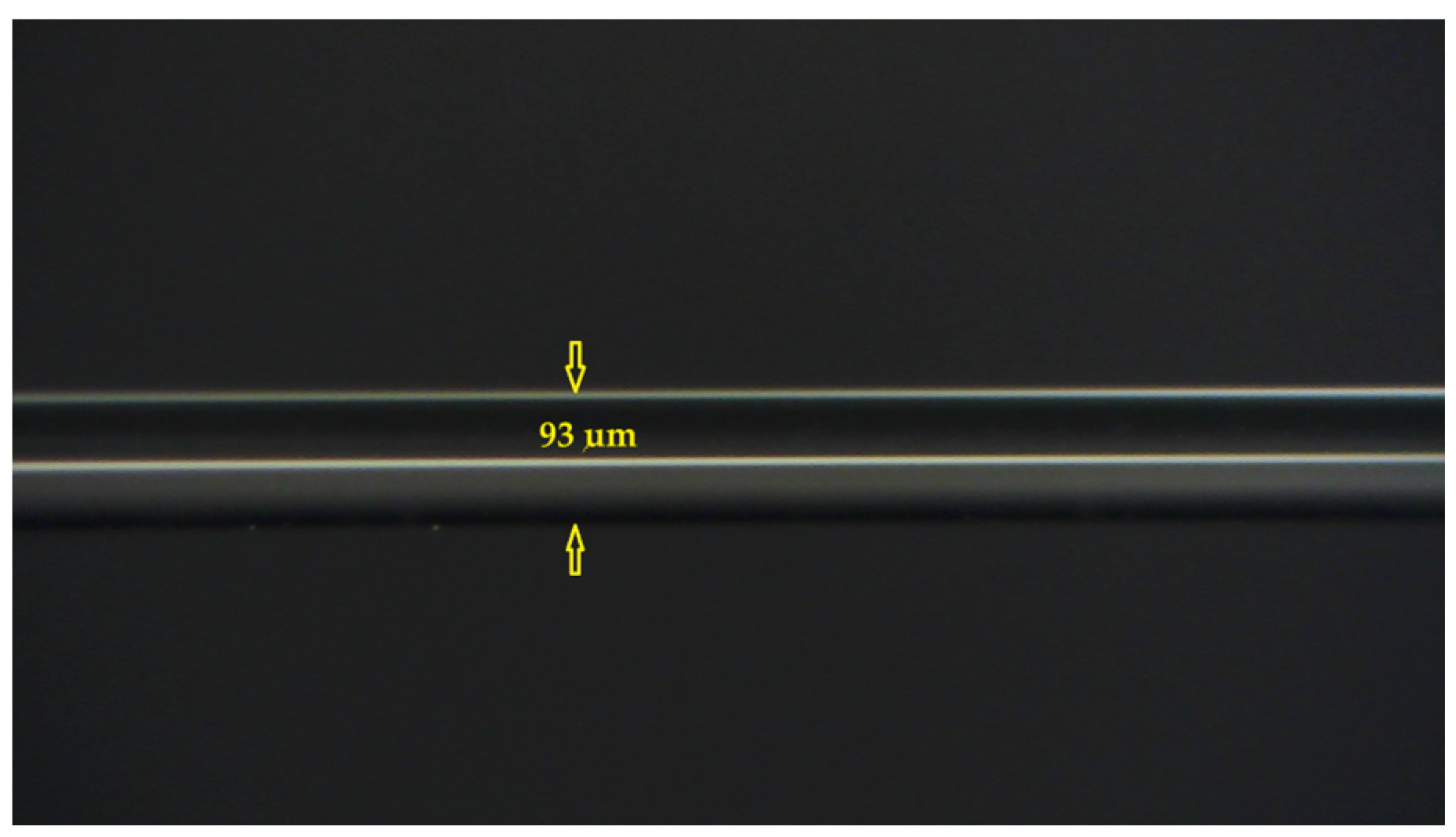
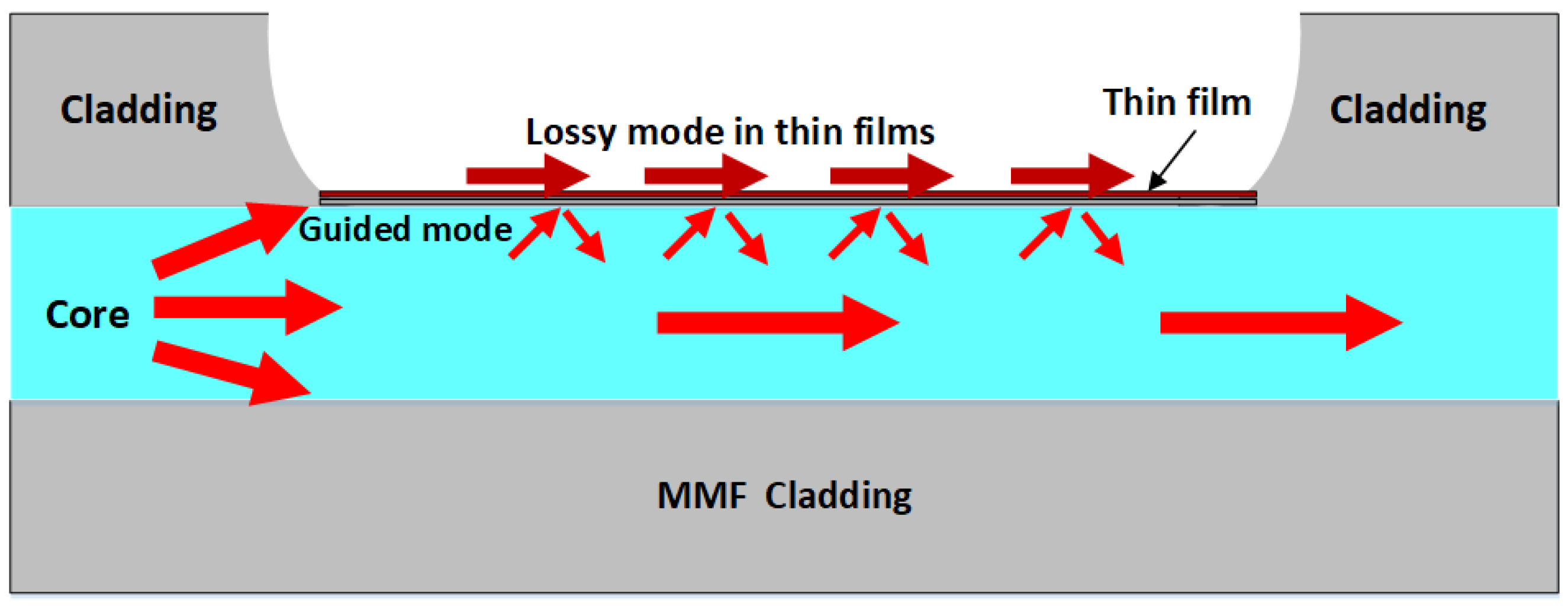
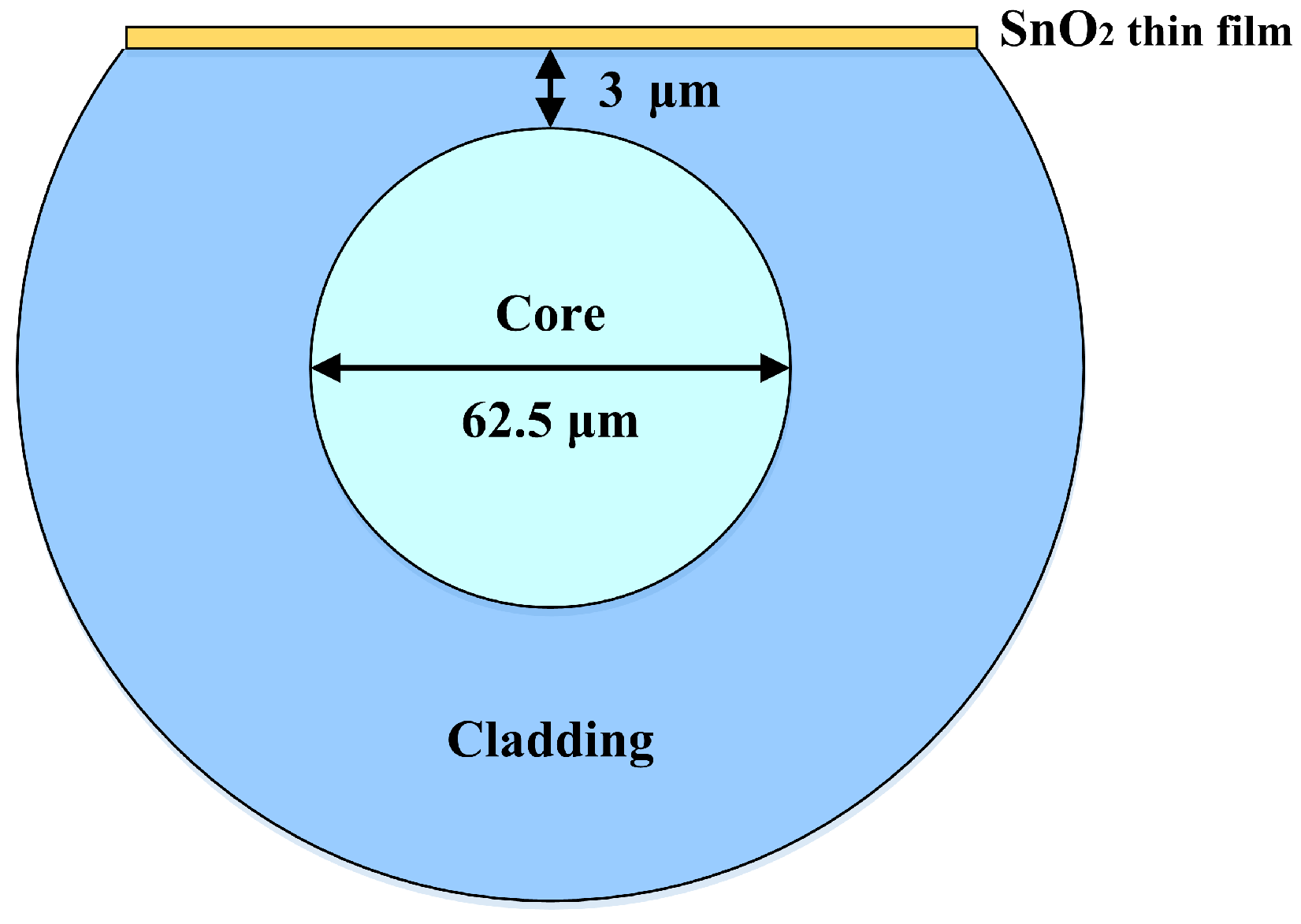
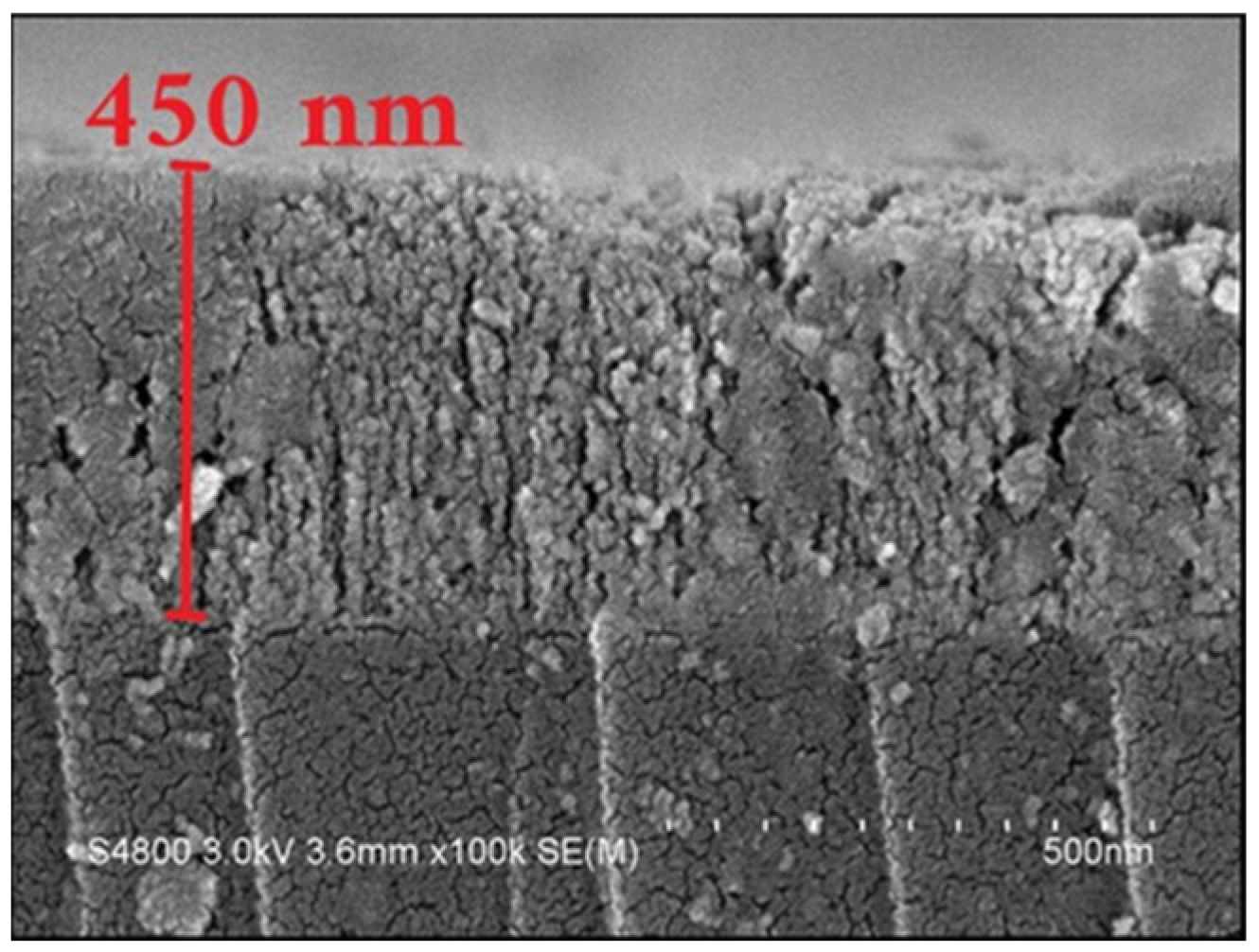
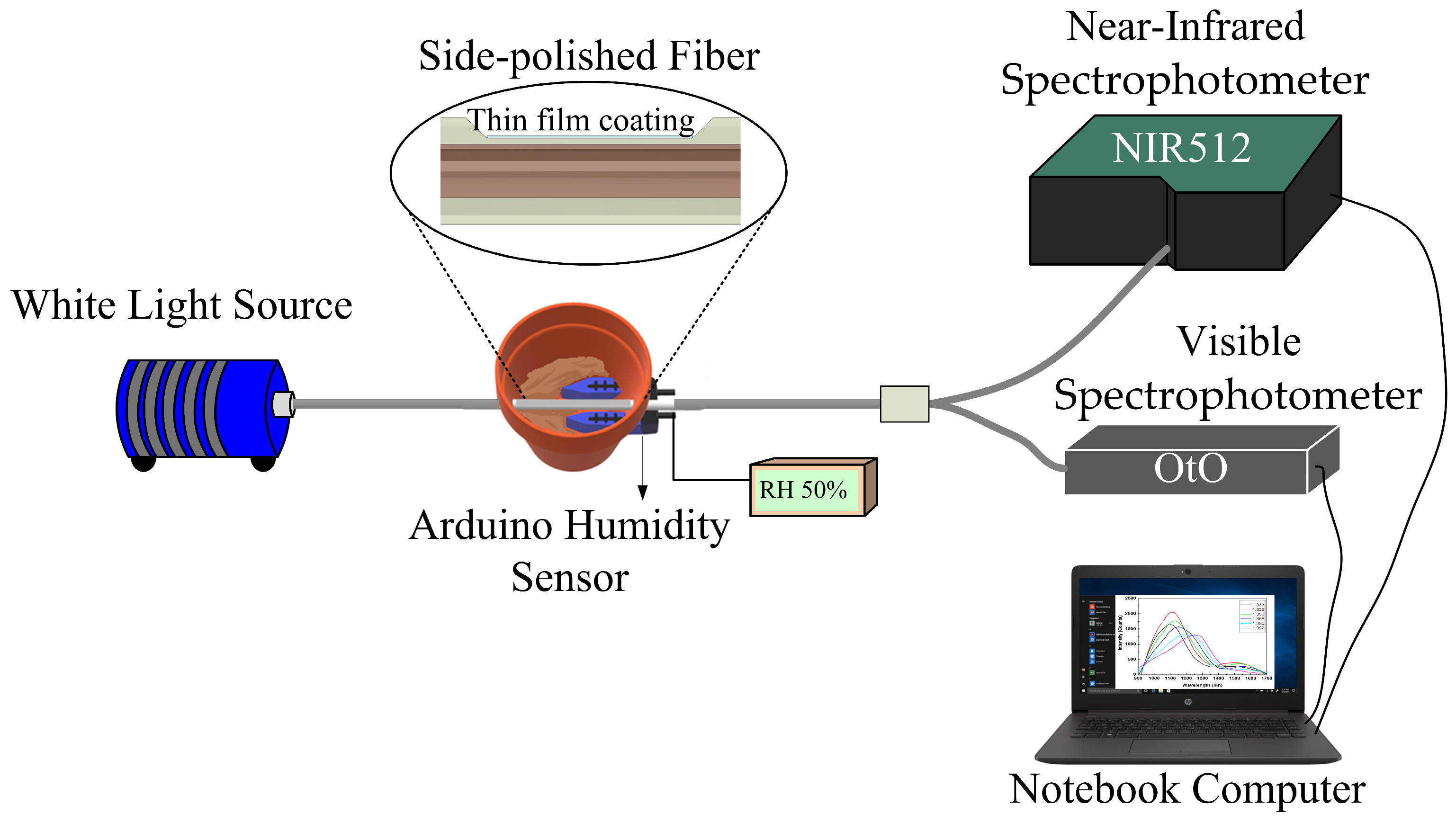
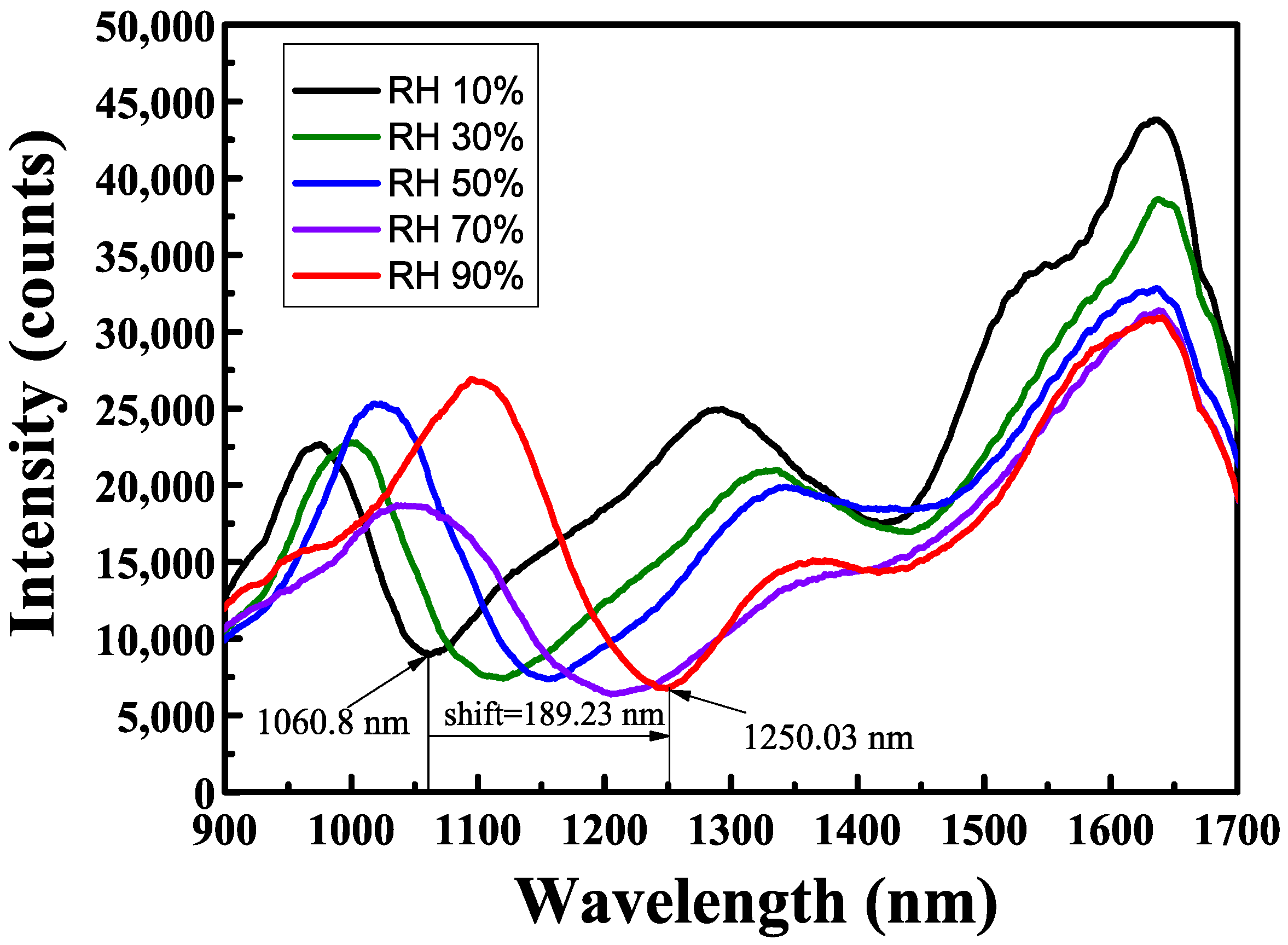
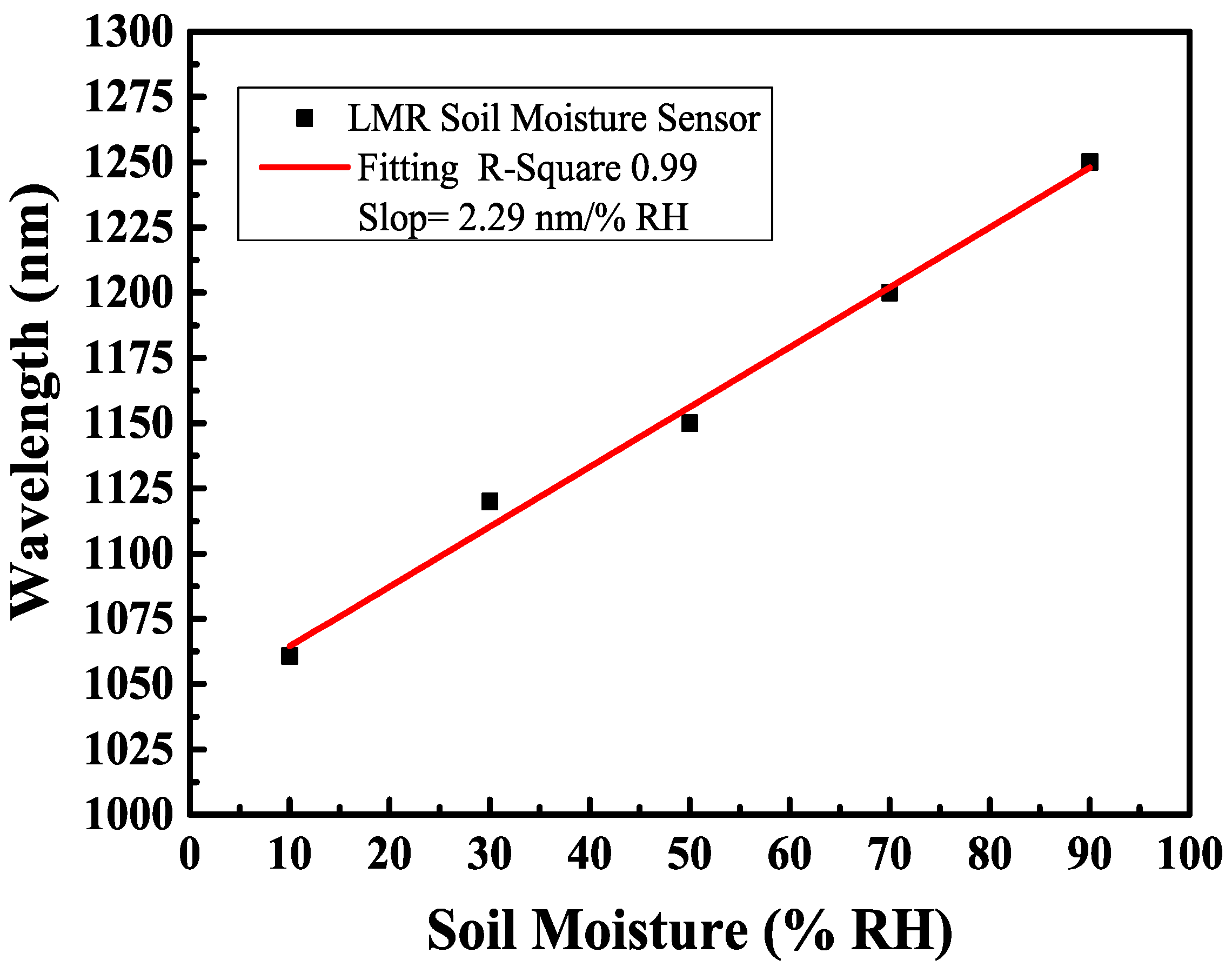
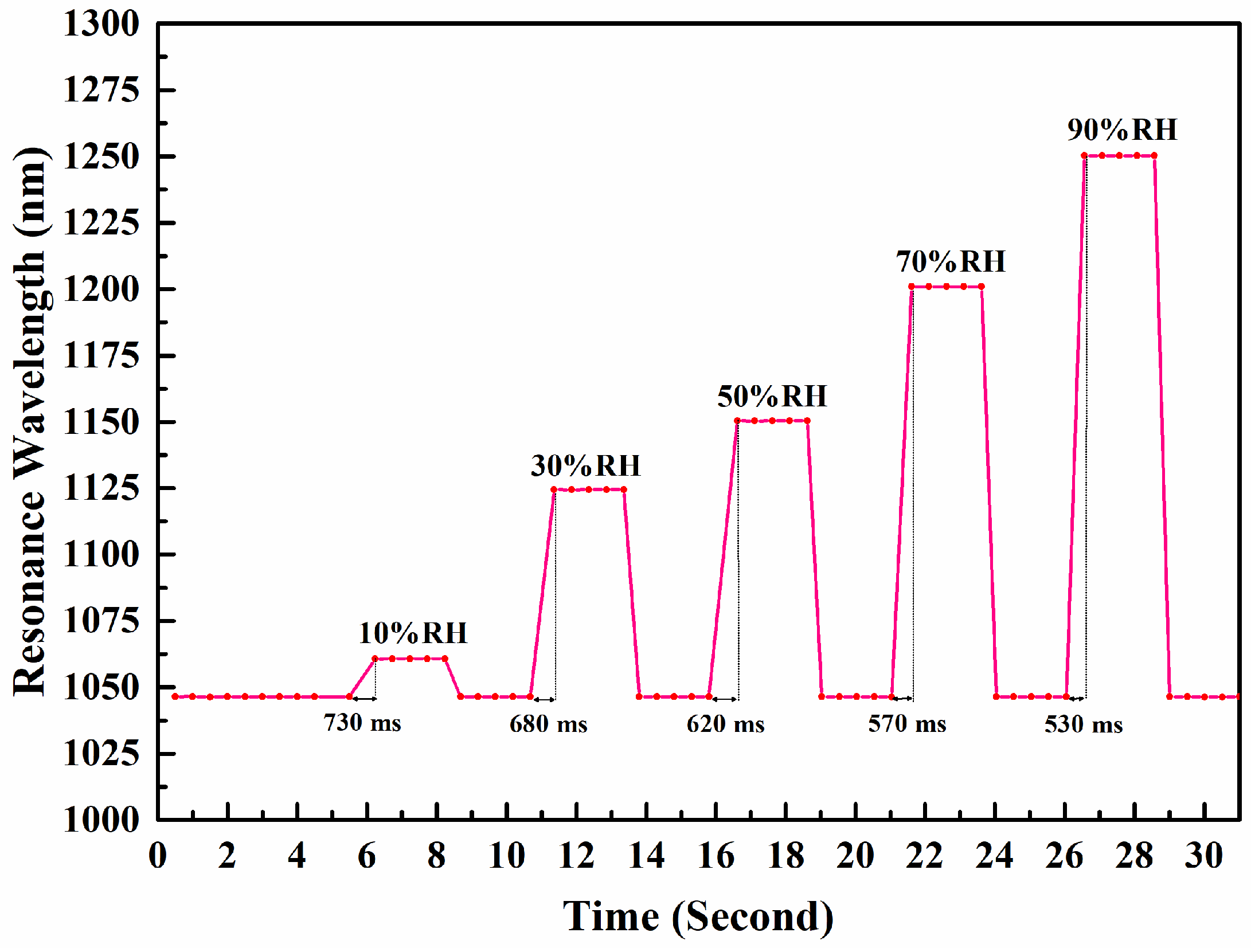
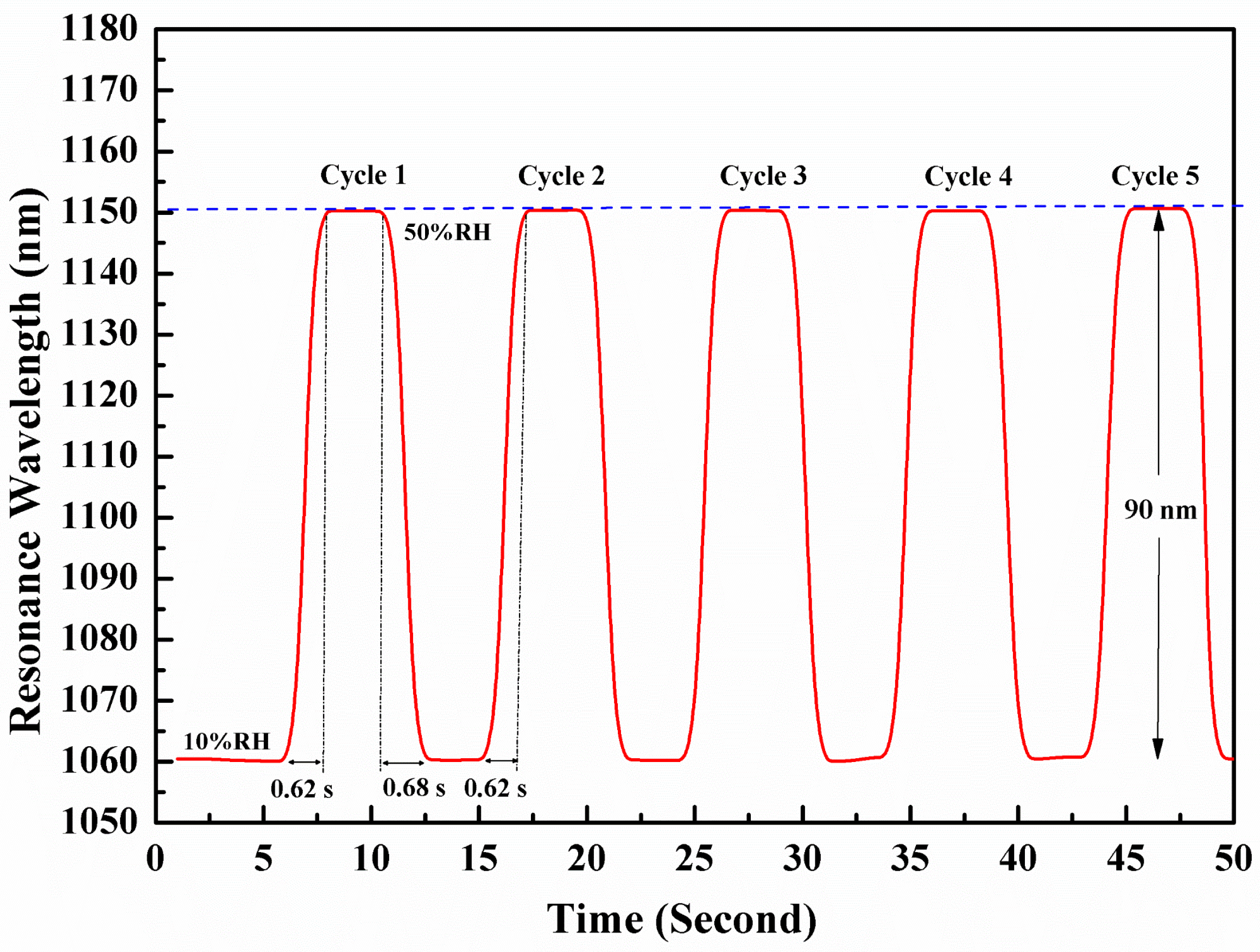
| Structure | Materials | Range (%RH) | Max. Sensitivity | References |
|---|---|---|---|---|
| LMR-based MMF | Graphene oxide | 20–90%RH | 0.612 nm/%RH | [20] |
| LPG array | Silica nanoparticle | 45–95%RH | 0.53 nm/%RH | [21] |
| Fiber Bragg grating probe | PMMA | 0–40%RH | 0.018 nm/%RH | [22] |
| Fiber Bragg grating | Polyimide | 11–97%RH | 2.0 pm/%RH | [24] |
| Fabry–Perot based | PNIPAM | 45–75%RH | 1.634 nm/%RH | [25] |
| Localized SPR | Au nanosphere | 60–90%RH | 0.634 nm/%RH | [26] |
| LMR-based MMF | SnO2 thin film | 10–90%RH | 2.29 nm/%RH | This work |
Disclaimer/Publisher’s Note: The statements, opinions and data contained in all publications are solely those of the individual author(s) and contributor(s) and not of MDPI and/or the editor(s). MDPI and/or the editor(s) disclaim responsibility for any injury to people or property resulting from any ideas, methods, instructions or products referred to in the content. |
© 2024 by the authors. Licensee MDPI, Basel, Switzerland. This article is an open access article distributed under the terms and conditions of the Creative Commons Attribution (CC BY) license (https://creativecommons.org/licenses/by/4.0/).
Share and Cite
Tien, C.-L.; Shih, H.-F.; Tien, J.-K.; Wang, C.-C. A High-Sensitivity Fiber Optic Soil Moisture Sensor Based on D-Shaped Fiber and Tin Oxide Thin Film Coatings. Sensors 2024, 24, 7474. https://doi.org/10.3390/s24237474
Tien C-L, Shih H-F, Tien J-K, Wang C-C. A High-Sensitivity Fiber Optic Soil Moisture Sensor Based on D-Shaped Fiber and Tin Oxide Thin Film Coatings. Sensors. 2024; 24(23):7474. https://doi.org/10.3390/s24237474
Chicago/Turabian StyleTien, Chuen-Lin, Hsi-Fu Shih, Jia-Kai Tien, and Ching-Chiun Wang. 2024. "A High-Sensitivity Fiber Optic Soil Moisture Sensor Based on D-Shaped Fiber and Tin Oxide Thin Film Coatings" Sensors 24, no. 23: 7474. https://doi.org/10.3390/s24237474
APA StyleTien, C.-L., Shih, H.-F., Tien, J.-K., & Wang, C.-C. (2024). A High-Sensitivity Fiber Optic Soil Moisture Sensor Based on D-Shaped Fiber and Tin Oxide Thin Film Coatings. Sensors, 24(23), 7474. https://doi.org/10.3390/s24237474








